 Driving can wreak havoc on people who suffer from sciatica and piriformis syndrome.
Driving can wreak havoc on people who suffer from sciatica and piriformis syndrome.
Unfortunately, car seats are not ergonomically designed in a positive way. Which is fine for people who live free of pain but for those who experience sciatic pain and piriformis syndrome, getting into a car seat is like sitting into an iron maiden.
I learned about sciatica and piriformis syndrome intimately when my body broke down and I ended up in physical therpay for a year.
Even though I am not a sciatica sufferer, hour after hour behind the wheel can still put terrible demands on my body and I devised a number of strategies for driving and surviving. I hope they help.
I also learned how to walk correctly and began teaching people how to walk for pain relief.
My CoreWalking program has had tremendous success with issues like sciatica and piriformis syndrome. You can get more information if you would like, at the bottom of this post.
The following driving tips are for anyone and everyone but will especially serve those who are troubled by nerve issues in the lower spine and pelvis.
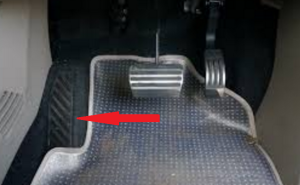 Left Foot On The Foot Pad Keep your left foot on the rubber pedal that is a feature in every car.
Left Foot On The Foot Pad Keep your left foot on the rubber pedal that is a feature in every car.
This allows both legs to be in relatively the same position which gives you the best chance to maintain a balanced pelvis.
Your knee will be bent slightly depending on how near or far from the steering wheel your seat is situated.
People adjust their seats for different reasons and I don’t think it is great to be too close to the steering wheel.
Giving the legs a little room to lengthen is a good choice.
There are a number of bad choices available for left leg.
Keeping the foot flat on the floorboard, with the knee bent, instead of on the pedal creates an extreme flexion that would be better off to avoid.
But I have also seen people crossing the left foot both over and under the right thigh. It’s best to be nice to your left leg and keep your left foot on the pedal provided.
![]()
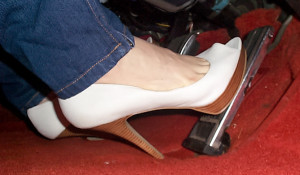 Right Heel Under the Gas Pedal The right foot should be parallel as much as possible.
Right Heel Under the Gas Pedal The right foot should be parallel as much as possible.
There is a tendency for the heel of the right foot to live between the gas and brake pedals, allowing the foot to pivot between the two.
Over many hours, or even minutes for some, this slight external rotation can tweak the piriformis.
Especially when going to brake after a long time on the gas pedal.
It is best to keep the heel directly in line with the bottom of the gas pedal and shift the whole foot and leg to the brake and then back to the gas maintaining a parallel alignment of the right foot.
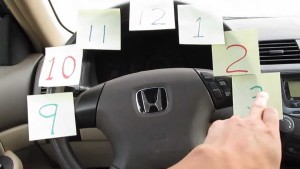 Hands At Nine And Three You might not think that your arms are involved with sciatica and piriformis syndrome but if you hold your hands at nine o’clock and three o’clock on the steering wheel you are balancing the sides of your trunk.
Hands At Nine And Three You might not think that your arms are involved with sciatica and piriformis syndrome but if you hold your hands at nine o’clock and three o’clock on the steering wheel you are balancing the sides of your trunk.
Just like keeping the left leg in a similar position to the right, both hands on the steering well creates the best environment for the pelvis to preserve a balanced position.
Driving one handed should be avoided because it allows for assorted misalignments and permutations of the trunk because the arms are free to perform two completely different actions.
Looking at the archetype of the American male driver—right hand on the top of the wheel and the left elbow resting out an open window, this position tends to lengthen the right side and shorten the left.
Switch sides and put the left hand on the wheel and the right elbow on the middle console and you will likely collapse the right side a bit.
Your best option is to keep your hands at nine o’clock and three o’clock and treat the sides of your waist kindly.
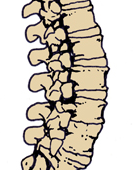 A Curve in the Lower Back Keeping a curve in the lower spine is a challenge anytime you sit in a car.
A Curve in the Lower Back Keeping a curve in the lower spine is a challenge anytime you sit in a car.
The pelvis wants to tuck and the lower back tends to meld with the seat back.
Every effort to avoid this and any attempt to find the best position for the spine can pay great dividends.
The ability to find this posture requires core tone that some people have and others need to develop.
The resting tone that we have before we get into the car determines how long we can drive in an optimal position once we are on the road.
If you don’t have the balance and tone required of your musculature you might actually need to fake it before you make it so that you can keep your lower spine curved in the correct way.
Once we lose the alignment of the spine and/or tuck the pelvis we are putting the sciatic nerve and piriformis muscle into a very vulnerable position.
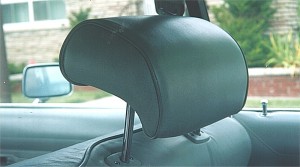 Head On the Headrest I have written about the phenomenon of the evil headrest conspiracy.
Head On the Headrest I have written about the phenomenon of the evil headrest conspiracy.
There is no doubt that car company’s mean well when they install a head rest that reinforces forward head posture which is already the most common postural misalignment.
But meaning well and doing well often follow different trajectories.
The design is intended to reduce whiplash injuries but the cost to the position of our head and neck is not in any way worth it to me.
No matter where your headrest resides, the back of your head should be against it, lengthening the back of the neck so that your eyes are level and you can maintain your gaze level with the horizon line.
We are habitual creatures who tend to find a pattern and stick with it. Unfortunately there is nothing that insures that our behaviors are for the best.
We don’t naturally choose healthy positive patterns when it comes to movement and posture.
Good patterns will only come with awareness and conscious choice. Try using these tips to get you started on a better driving routine.
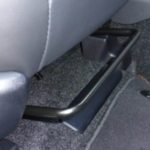 Adjust Your Seat (A Little) In Tip #1 I said you should distance your seat so your leg has room to extend comfortably.
Adjust Your Seat (A Little) In Tip #1 I said you should distance your seat so your leg has room to extend comfortably.
This remains true but when it comes to pain, stillness is often an adversary.
I can’t tell you the number of injuries that occur after we sit or stand too long and then move.
To avoid this, especially on long trips, find a position you like and after 30 minutes slide the seat 1 setting forward.
After another 30 minutes, take the seat back 2 settings.
After another 30 minutes, return to your preferred position.
The Cabbie Solution This tip doesn’t appeal to everyone’s aesthetic sense but function over form should win out when it comes to pain relief.
A soft seat that welcomes us to sink deep into it does not serve us well.
And while it might seem counterintuitive to think putting your butt on a hard surface will help with lower back and butt pain, that hard surface will allow you to find, and maintain, much better alignment.
